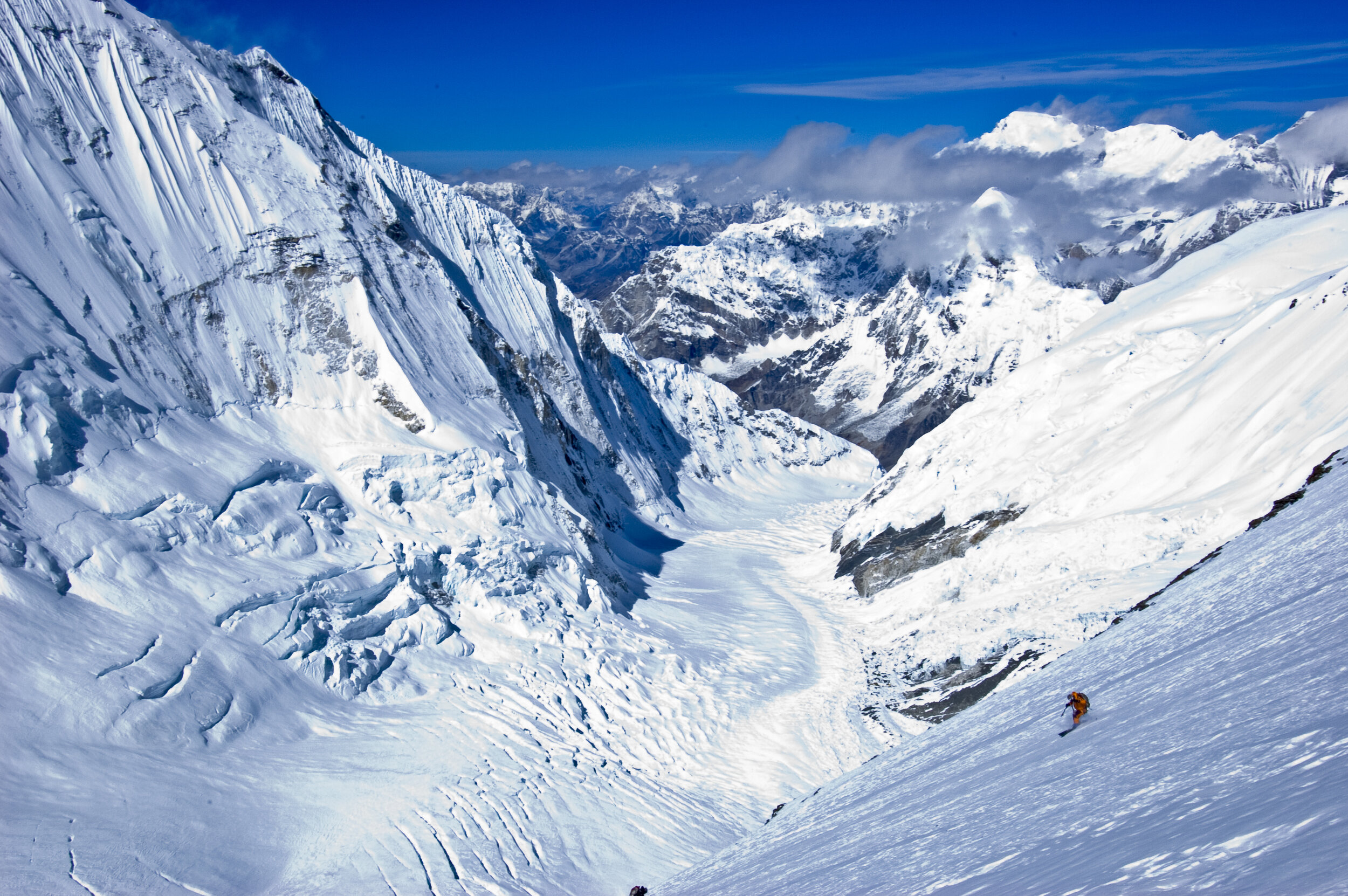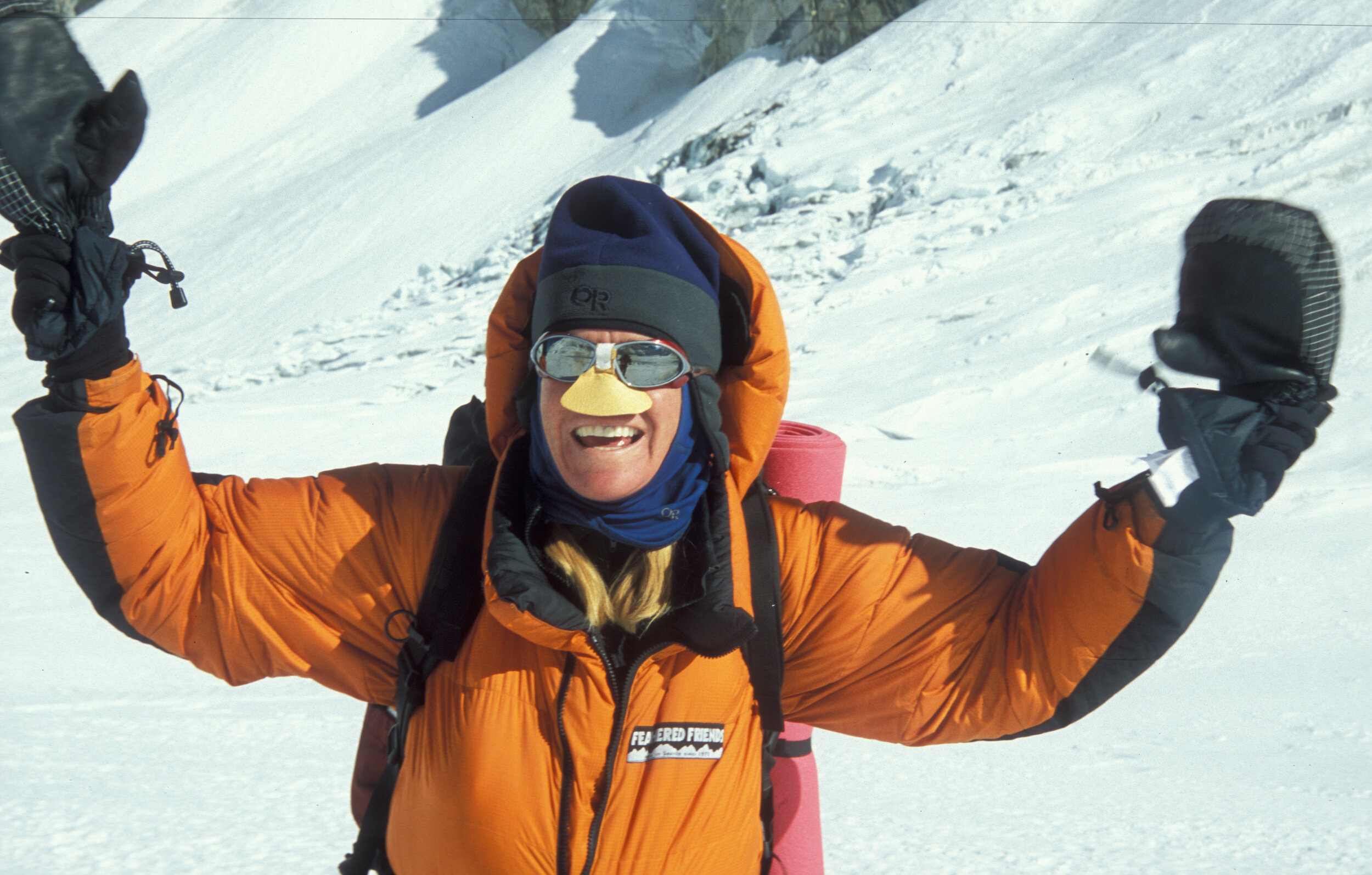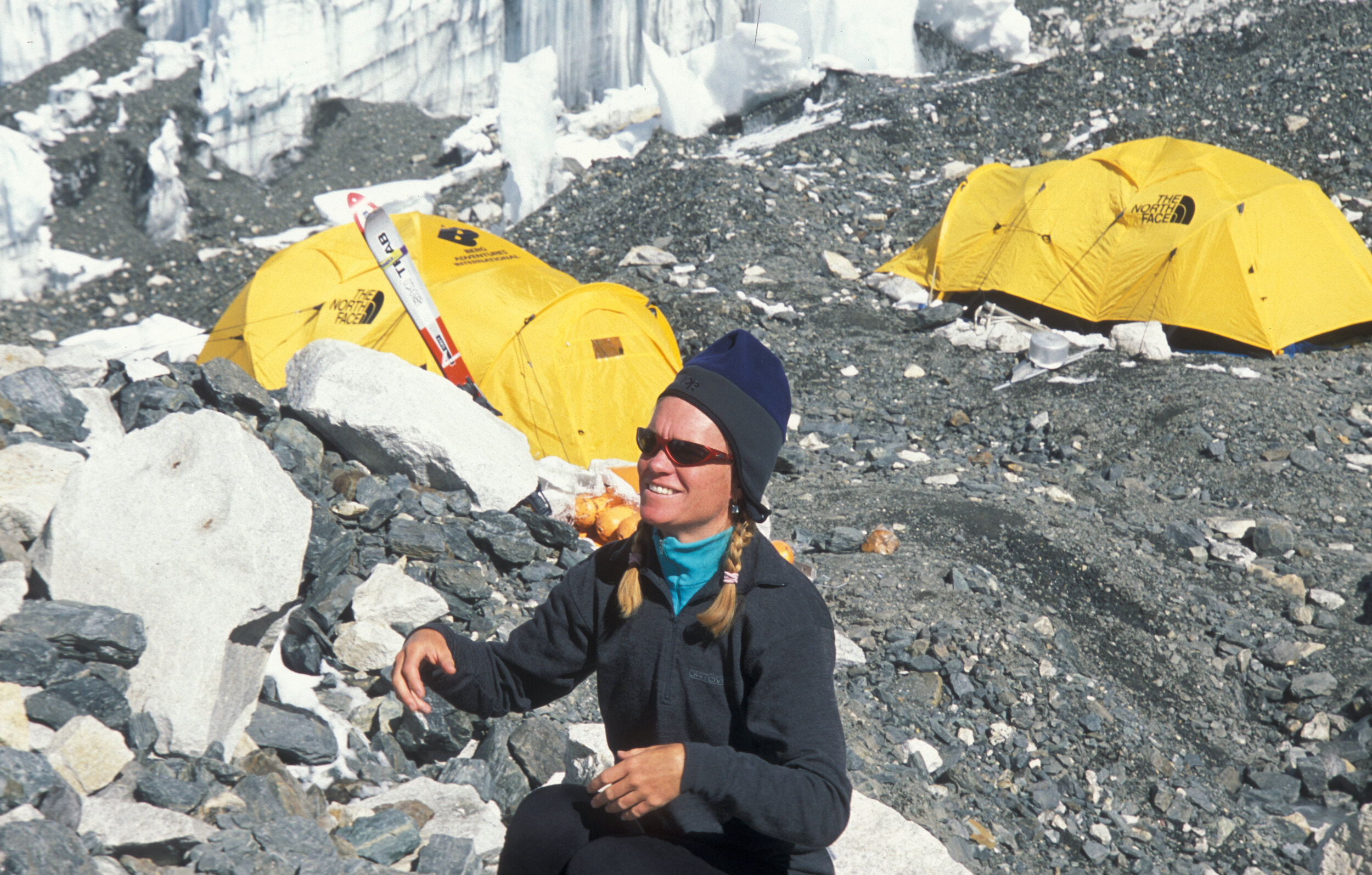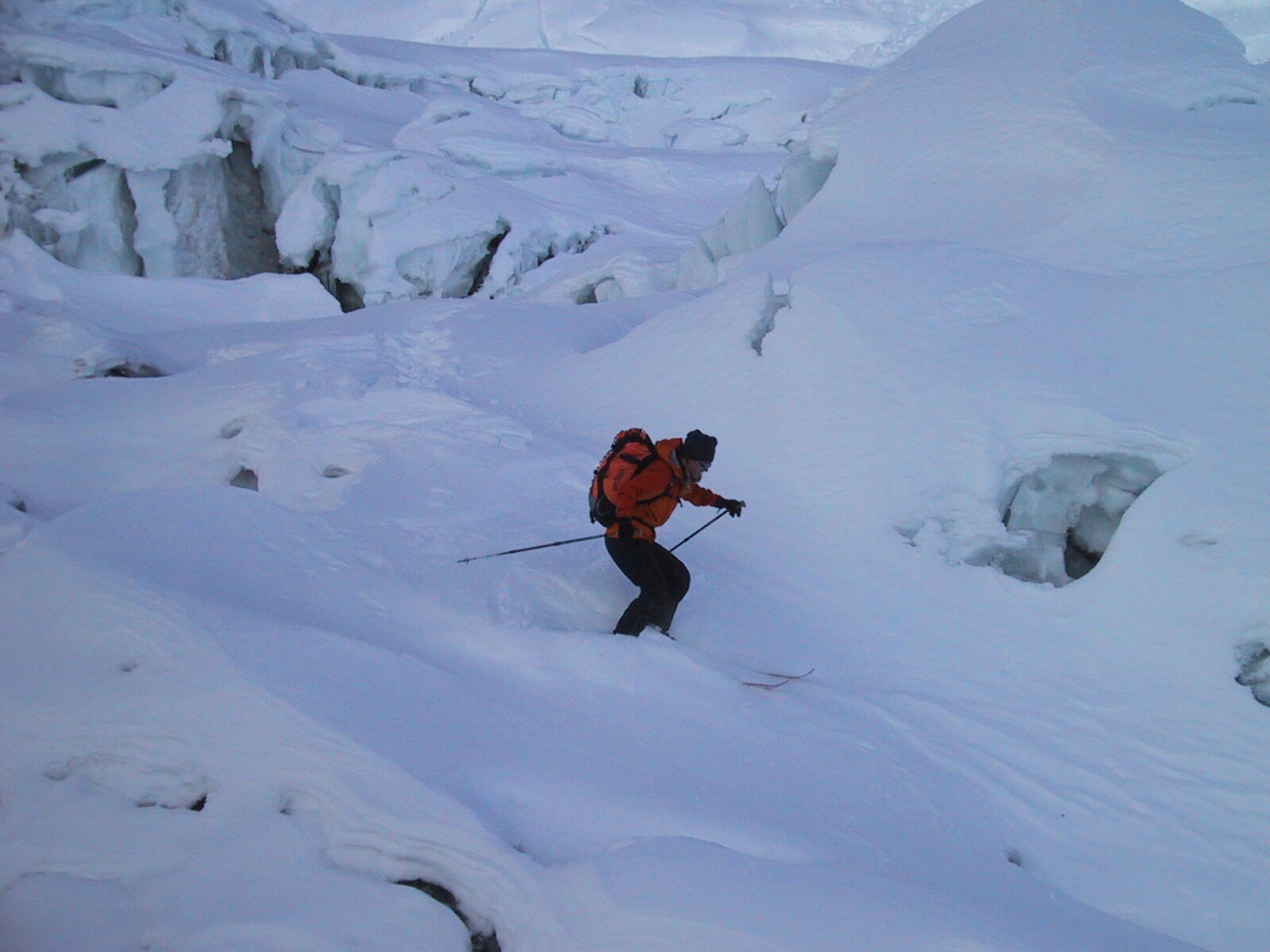HIGHER LOVE AND THE QUEST TO SKI EVEREST
By Lynn Martel
Only one woman can become the first woman to ski down Mt. Everest. It was a lofty goal for Canmore’s Maegan Carney, and one that slipped through her fingertips in 2003. Lynn Martel reports on how Carney’s journey intersects with Kit Deslauriers’ successful descent of the world’s highest mountain in October 2006. Deslauriers recently presented her new book, Higher Love: Skiing the Seven Summits, at the 2015 Banff Mountain Book Festival.
Skiing down Mount Everest was, hands down, no contest, the most difficult, frightening, dangerous and challenging ski descent of Kit Deslauriers’ life.
“It was wicked hard,” Deslauriers said. “It was truly, truly extreme, very steep, very challenging, very icy. It was free-soloing at a high level, one turn at a time. I literally had to talk myself through it like that – one turn at a time. I never want to ski anything like that ever again.”
JOURNEY TO THE SEVEN SUMMITS
Deslauriers’ journey to become the first person to ski the Seven Summits – the highest points on each continent – began at 14 when, having grown up cross-country skiing on flat farmers’ fields in Massachusetts, she made her first downhill turns.
“It wasn’t easy right away, it was a challenge,” Deslauriers said. “But right away I enjoyed the relative freedom, how you got to use your own personal expression and style down a mountain.”
As soon as she graduated from college, she fulfilled a vow she’d made at 15 during her first visit to Telluride, Colorado, and moved to the picturesque mountain town. While earning her living waiting tables, laying carpet, ski patrolling and becoming a stone mason, she raised a wolf pup and learned how to ski.
But it wasn’t until she moved to Jackson Hole, Wyoming, where she and her husband, Rob Deslauriers, are now raising two daughters, that she decided to push higher. After just two years of competing – and learning to take air and land jumps at increasingly higher speeds and heights – she won back-to-back world freeskiing titles. Following the 2004 championships in Alaska, she and Rob – whom she met on a ski expedition in Siberia – carried on to Denali, where she became the first American woman to ski from North America’s highest summit.
Following her 2005 freeskiing championships win in Utah, Deslauriers met Dick Bass, the first person to climb the Seven Summits (via the “Bass version.”)¹ He gave her a copy of his book, and Deslauriers set a new goal: to ski them all. A fellow Jackson Hole skier was impressed with her slope skills and offered to cover all her travel and associated expenses. With that, Deslauriers began to study the optimum snow seasons for objectives like Kilimanjaro in Africa, Aconcagua in South America and Kosciusko in Australia.
With 6194-metre Denali already behind her, she quickly knocked off Russia’s Elbrus, then skied the remaining five peaks over an impressively speedy 16 months.
SAVING THE BIGGEST FOR LAST
Everest, which she chose to ski in the post-monsoon month of October, was her last. For support, she turned to Canmore resident Wally Berg, a dual Canadian-US citizen who has summited Everest five times, to be her team leader. While Everest is known to be crowded in springtime, autumn is a different story.
“There was no one else on the mountain,” she said. “It was very much a wilderness landscape.” With Berg coordinating the team from base camp, Deslauriers and her teammates spent weeks fixing ropes, ferrying loads and establishing camps higher up. As the days grew shorter, the jet stream moved south pushing moisture out and causing temperatures to drop and winds to grow increasingly fierce.
“Our reality was seven weeks at or above basecamp, 17,000 feet,” she recalled. “It wasn’t just the physical toll, but the mental one. It’s a long time to stay committed. The biggest challenge was maintaining the mental fortitude to be relaxed and detached from the outcome, while still being focused on the outcome. That takes a lot of energy.”
When a big storm dumped massive amounts of snow on the mountain resulting in large avalanches, all the fixed lines needed to be reset. Did Deslauriers’ determination waver?
“Absolutely,” she admitted. “But I believed I could do it – I had to believe I could do it.”
Others did, too. In addition to the encouragement of her husband, Berg and her expedition partners, Deslauriers had another supporter who understood intimately what she was facing.
CARNEY’S CONNECTION
Three years earlier, Canmore resident Maegan Carney was also climbing Everest. It was also October, and she was also part of a Berg-organized expedition. A two-time world extreme skiing champion, Carney was a professional big mountain skier with first ski descents in the Alps and the Himalaya under her bindings, including a solo ascent (following fixed lines) of 6812-metre Ama Dablam, and a ski descent of 6440-metre Cholatse (from the skiable part beginning at 6000 metres). Carney was there to become the first woman to ski Everest.
She climbed as high as Camp 3 at 7315 metres, twice. Then, following a big storm, two Sherpas were injured in an avalanche. The winds raged. Twice she dreamed if she climbed higher, she would die.
“The winds were so intense, I watched all my snow get blown away,” Carney recalled. “It was heartbreaking for me. I definitely had all my eggs in one basket. I hadn’t even entertained the thought of not even being able to try.”
Raising the money and securing sponsorship to climb Everest had been extremely difficult and Carney left the mountain un-skied. On the positive side, it was on that expedition that she met ACMG/IFMGA mountain guide, Grant Meekins. She moved to Canmore with him soon afterward, where they are raising a son and she is a practicing psychotherapist and life coach.
In 2006, Carney followed Deslauriers’ expedition via dispatches on the Berg Adventures International website. She sent an email, which Berg relayed by radio to Deslauriers higher on the mountain.
“I was excited for her,” Carney said. “I knew they’d be headed to the summit, and I wanted to wish her good luck. I wanted her to have a chance at it, to get to the top and have a good shot. I wished her luck and calm winds.”
CLOSE TO IMPERMANENCE
On October 18, 2006, Deslauriers reached the summit with Rob and adventure photographer, Jimmy Chin – his second time summitting Everest. In all, 14 expedition members reached the summit that day, including eight Sherpas and US guide Dave Hahn, his eighth time.
At 11 a.m., Deslauriers began to ski down. At the Hillary Step, she stopped. At the bottom of the 12-metre vertical rock cliff, Rob, who had gone ahead to film her, was unconscious having run out of oxygen. Realizing the Hillary Step was dry and un-skiable, they made a safety call and all three descended the summit ridge carrying their skis. At a section known as the Triangular Face they skied again, then collapsed in tents at the South Col. After a brutally cold night, in the morning they began skiing down the 1525-vertical-metre Lhotse Face via the never-skied South Pillar route.
At 40 to 50 degrees, the steep pitch was hard as marble. In some places, they had to negotiate their way around glare ice and 80-degree bulges. With sharp ski poles in one hand and ice axes in the other, they could not pierce the surface. Chin, the consummate adventure photographer, declared he could not shoot this section of their ski descent because he couldn’t get his pole or axe into the ice to free his hands.
“You couldn’t self-arrest, even with the ice axe. I think that’s a remarkable statement of how difficult it was,” Berg said.
Recalling that day, Deslauriers noted that while ski descents don’t yet have a grading system, affixing R/X – climbing terms for run-out with any fall likely to result in death – would be totally appropriate. No one has even attempted to ski the line since. How did she feel when they reached the bottom?
“Alive,” Deslauriers said. “I had come as close to impermanence as I could while still being alive. As time goes by, I find it more and more astounding what we were able to do.”
A UNIQUE EXPERIENCE
For Carney, their success brought mixed feelings.
“A part of me was just heartbroken,” Carney admitted. “I thought: it’s done. But after going through the feelings of sadness, I came to this place of being so proud of her. I was able to feel the whole inspiration of what she’d done.”
Nearly a decade later, Berg said he continues to be inspired by the accomplishments of both remarkable women.
“It has been one of the great privileges of my life to know them both well,” Berg said. “They are probably the two most self-directed, inspiring women that I have ever known.”
Now sharing her story in her book, Higher Love, Deslauriers cherishes that experience – one shared by fewer people than have walked on the moon.
“It’s the most difficult thing ever that any of us has skied,” she said. “It’s pretty cool to have a friendship built on an experience like that. When you share something as memorable and as unique as we did, what we experienced as individuals and as a team, that’s incredibly unique. It’s very special.”
For your copy of Higher Love: Skiing the Seven Summits, by Kit Deslauriers, visit kitdski.com
Read more about Kit Deslauriers, Maegan Carney and Wally Berg in Lynn Martel’s book, Expedition to the Edge: Stories of Worldwide Adventure, available at lynnmartel.ca
1 While serious climbers consider the highest point of the Australasian continent to be Indonesia’s 4884-metre Carstenz Pyramid – known as the “Messner version” of the Seven Summits, which was first completed by Canadian Pat Morrow in 1986 – since it’s a technical rock climb with no glaciers or snow Deslauriers chose 2228-metre Kosciusko, which can be skied.
Author of two books of adventure and nine mountain biographies, Lynn Martel explores the Canadian Rockies backcountry by skis, boots, camera and the written word.








